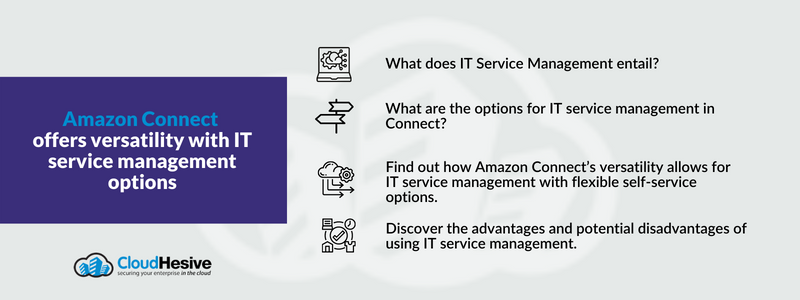Amazon Connect offers versatility with IT service management options
The business network is the lifeblood of a business. Without the complex and interwoven network of systems, data, and communications, a business cannot survive. It is the single most important aspect of managing and growing a business, but network management also consumes a great deal of time, resources, and money. Businesses must choose between managing an internal, on-premises team of IT experts in systems, data, communications, and security or using an IT service management provider.
When tackling the management of communications regarding customer service or customer contact centers, Amazon Connect provides a mix of self-service configuration options along with access to use all of AWS’s IT service management options. But will it work for your IT Service Management needs? What are the alternatives to using an IT service management option? Can aspects of IT be internally managed and then allow Connect to manage the rest?

This article provides information on the business value of using Connect and its IT service management options in place of or along with an internal IT group.
What does IT service management mean to a business?
Business networks require upkeep, monitoring, and constant updating for new releases, builds, and security patches. Keeping a business network healthy requires dedicated care and attention. For decades managing a network has meant hiring an internal IT team. However, there is another option: IT service management.
IT service management functions vary and include:
- Providing supplemental support to internal IT staff as needed.
- Providing specialized IT services for security, messaging, communications, or data management.
- Full replacement of internal IT staff paid by service subscription based on the business needs.
IT service management typically lowers the cost and overhead of hiring, managing, and paying for specialized resources. Exceptional, highly qualified IT specialists that can cover security, communications, and data are rare but do exist. However, it’s often outside a business’s financial means to retain a specialized staff and keep them interested in maintaining systems long-term. By using IT service management in some form, businesses save money on both resources and overall costs.
Most IT service management offers the following types of IT management services:
- Network administration
- Database management
- Security
- Communications
- IT or help desk support
The majority of businesses prefer to own some aspects of their IT management needs and turn the rest over to a managed service provider. AWS is a managed service provider and Amazon Connect specifically allows for the management of communications for customer service or contact centers.
Advantages and potential disadvantages of IT service management
The advantages of using IT service management include:
- Always-on Availability
- Scalability as needs change helps manage cost
- Minimized downtime
- Constant system monitoring
- Qualified experts handling specific network management functions
- No vacation or training costs for IT resources
- System familiarity over several resources, albeit external
- Access to new technology and standardized tools
The potential disadvantages of using an IT service management provider include:
- Management of resources via a contract or SLA rather than direct control.
- Service typically requires entering information into a ticketing system.
- Loss of the resident internal expert.
- An internal expert’s understanding of the business system is handled by an external resource.
Managed services provide distinct benefits, the number of which is truly determined by the provider, the details of the contract, and how much the business hands over to be managed. As mentioned earlier, a business can choose to self-manage some aspects of IT and assign other tasks to the IT service management provider. For example, a business may decide to manage their security with an in-house expert but contract the rest with a managed service provider.
What are Amazon Connect’s IT system management options?
The beauty of Amazon Connect is its versatility. Connect enables organizations to self-manage the customization and configuration of their system. In other words, the business decides and deploys only the managed service components it wants to use. For Connect, that’s the communications management segment that allows for managing customer service or contact centers efficiently and providing a quality, coordinated customer experience.
The options available in Amazon Connect include:
- Omnichannel cloud contact center
- Seamless communication integration, no more need for manual tracking
- Single tool and interface to manage all customer experience tasks
- Integration with business tools such as Salesforce so all data is accessible from one tool.
- Business controls and manages their customized configuration based on their needs.
Additionally, the business can use Connect along with other AWS-managed service options including:
- Development
- Storage
- Database
- AI
- Analytics
- Messaging
- Security
- Network management
The business controls what services they use. The system scales up and down as business needs change. Many businesses start with Connect to provide seamless communication management for improving customer experiences and then add on other services like security, analytics and database as they move forward.
Making the most of Amazon Connect’s options for customer experience management
IT service management provides flexibility for managing the various critical aspects of a business network. Using managed services for some or all network management needs results in lower and predictable costs. Additionally, experienced experts are available to manage the network without interruption.
Connect offers the full benefits of AWS’s IT management service options while also allowing customers to perform self-service configuration management. In other words, the business configures its system and chooses what options to use from a list of managed service options.
Need assistance determining how to use managed services from AWS? CloudHesive provides support and deep expertise in using the Amazon Web Services cloud for the best business advantage. As an Amazon Managed Services partner and Amazon Premier Partner, CloudHesive helps businesses take full advantage of all the features AWS offers, including Amazon Connect Contact Lens. See what other customers have to say in case studies available from CloudHesive.



